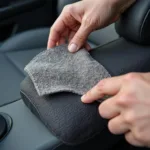Car seat covers are constantly exposed to wear and tear, from spills and crumbs to the sun’s harsh rays. Over time, this can lead to rips, stains, and general wear, diminishing the look and feel of your car’s interior. Knowing how to repair a car seat cover can not only save you money but also keep your car looking its best. This guide will provide you with the knowledge and techniques to tackle a range of car seat cover repairs, from minor fixes to more significant restorations.
Identifying the Damage: The First Step in Car Seat Cover Repair
Before you can repair your car seat cover, you need to identify the type and extent of the damage. This will dictate the best course of action and the materials you’ll need. Here are some common types of car seat cover damage:
- Tears and Rips: These can occur from sharp objects, pet claws, or simply wear and tear over time.
- Burns: Cigarettes, lighters, and even hot surfaces can cause unsightly burns on fabric and leather seats.
- Stains: Food and drink spills, ink, and dirt can leave behind stubborn stains.
- Fading and Cracking: Prolonged exposure to sunlight can cause leather and vinyl seats to fade, crack, and become brittle.
- Worn-Out Padding: Over time, the foam padding beneath your car seat cover can lose its shape and support.
Essential Tools and Materials for Car Seat Cover Repair
Having the right tools and materials on hand will make your car seat cover repair project go smoother. Some common items you may need include:
- Cleaning Supplies: A gentle upholstery cleaner, microfiber cloths, rubbing alcohol, and a soft-bristled brush.
- Repair Kits: Leather repair kits, vinyl repair kits, and fabric repair kits are available at most auto parts stores.
- Adhesives: Fabric glue, leather adhesive, or a heavy-duty spray adhesive.
- Patching Materials: Leather patches, vinyl patches, or fabric scraps that match your car’s interior.
- Sewing Supplies: A needle, thread that matches your car seat cover, and scissors.
- Heat Gun or Hairdryer: Useful for heat-activated adhesives and for restoring the texture of some materials.
- Subpatch Material (Optional): A strong, flexible material like canvas or denim to provide extra support for large tears.
Repairing Tears and Rips in Car Seat Covers
For Minor Tears in Fabric Seats:
- Clean the area: Use a gentle upholstery cleaner and a soft-bristled brush to remove any dirt or debris from the tear.
- Apply Fabric Glue: Apply a thin layer of fabric glue to the edges of the tear, being careful not to use too much.
- Press the Edges Together: Carefully align the edges of the tear and press them together firmly. Use a clean cloth to remove any excess glue.
- Allow to Dry: Let the glue dry completely according to the manufacturer’s instructions.
For Larger Tears or Rips in Fabric or Leather:
- Clean and Prepare: Thoroughly clean the area around the tear. If necessary, trim any frayed edges or loose threads.
- Create a Subpatch (Optional): For larger tears, cut a piece of subpatch material slightly larger than the tear. Apply adhesive to the back of the subpatch and carefully position it underneath the tear, smoothing it out to ensure good adhesion.
- Apply a Patch: Choose a patch that matches your car seat cover material. Apply adhesive to the back of the patch and center it over the tear, pressing firmly to secure it in place.
- Blend and Seal (Leather Only): If you are repairing a leather seat, you can use a leather filler compound to blend the edges of the patch with the surrounding leather. Once the filler is dry, use a leather sealant to protect the repair and restore the leather’s moisture.
For more detailed instructions on repairing specific types of tears, you can refer to our guides on how to repair foam rubber in a car seat, [how to repair a cigarette burn on a car seat](https://carrepairon.com/how to-repair-a-cigarette-burn-on-a-car-seat/), and how to repair hole in leather car seat.
Dealing with Burns on Car Seat Covers
“Burns, particularly cigarette burns, are unfortunately quite common,” says John Miller, a senior automotive upholstery specialist at Miller’s Auto Trim. “While prevention is always the best approach, effective repair methods can often restore the seat’s appearance.”
For Minor Burns on Fabric Seats:
- Gently Brush: Use a soft-bristled brush to remove any loose fibers from the burned area.
- Apply Fabric Shaver: If the burn is on the surface, you can try using a fabric shaver to carefully remove the damaged fibers.
- Conceal with Fabric Marker: A fabric marker that matches your car seat cover can help camouflage minor burn marks.
For More Severe Burns or Burns on Leather Seats:
- Assess the Damage: Determine if the burn has penetrated through the top layer of the material.
- Use a Leather Repair Kit: For leather seats, a leather repair kit can be used to fill in the burn and restore the surface.
- Patching: For severe burns on fabric or leather seats, you may need to patch the area using the techniques described above.
For step-by-step instructions on repairing cigarette burns, check out our guide on how to repair cig burn in car seat.
Conclusion
Repairing a car seat cover is a manageable task that can save you money and maintain the interior aesthetics of your car. By identifying the damage, gathering the right tools and materials, and following the appropriate techniques, you can address tears, burns, and other common car seat cover issues effectively. Remember to always prioritize safety and refer to your car manufacturer’s guidelines for specific instructions. With a little effort and patience, you can keep your car seats looking their best for years to come.
If you are dealing with more extensive damage or are unsure about tackling the repair yourself, consult a professional automotive upholstery specialist for assistance. They have the expertise and experience to handle complex repairs and can provide guidance on the best course of action.



